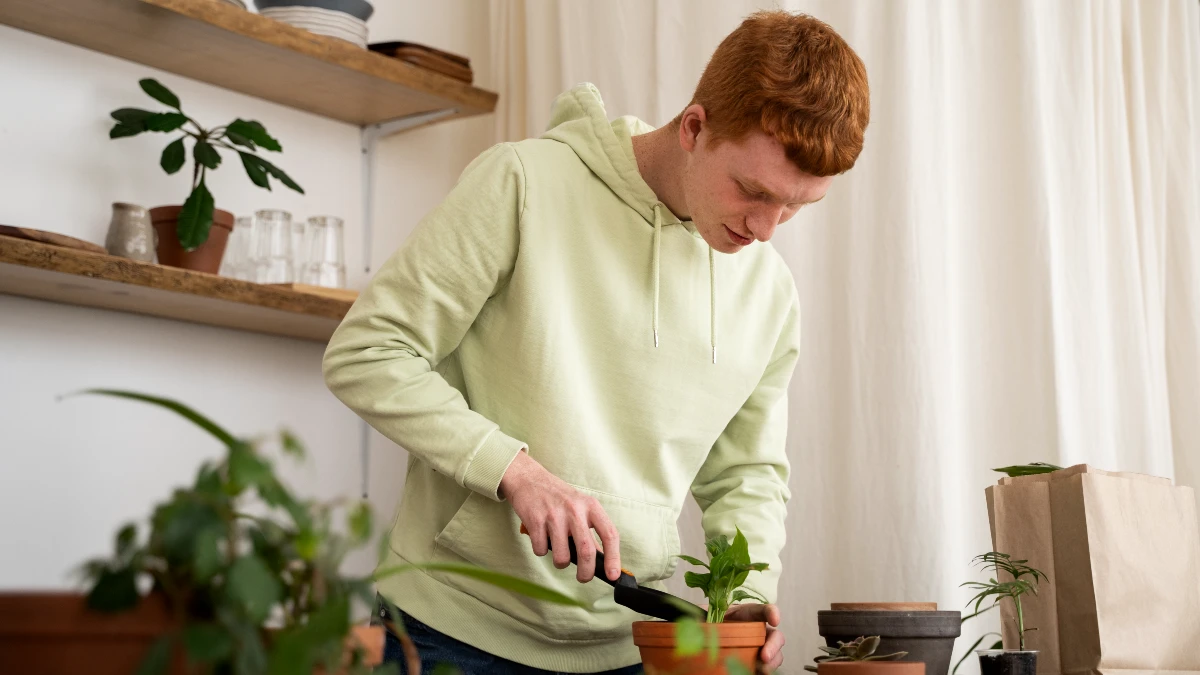Most dying houseplants aren’t thirsty—they’re drowning. Overwatering starves roots of oxygen. When roots sit in water, they can’t breathe, they rot, and the whole plant starts to fail. You see droopy, yellow leaves and think, “More water.” That makes it worse.
This guide shows you how to stop overwatering your plants fast. You’ll learn the signs of overwatering houseplants you can spot in seconds. You’ll get a safe rescue plan for a soggy plant. You’ll also set up a simple watering routine that works: the finger test, the lift test, how and when to leach salts, smart pot/soil fixes, plus optional tools like self-watering planters.
By the end, you’ll know the best way to water indoor plants so you prevent root rot in pots and keep plants growing. No complex gear. No guesswork. Just repeatable steps that fit real life.
Quick Test: Are You Actually Overwatering?
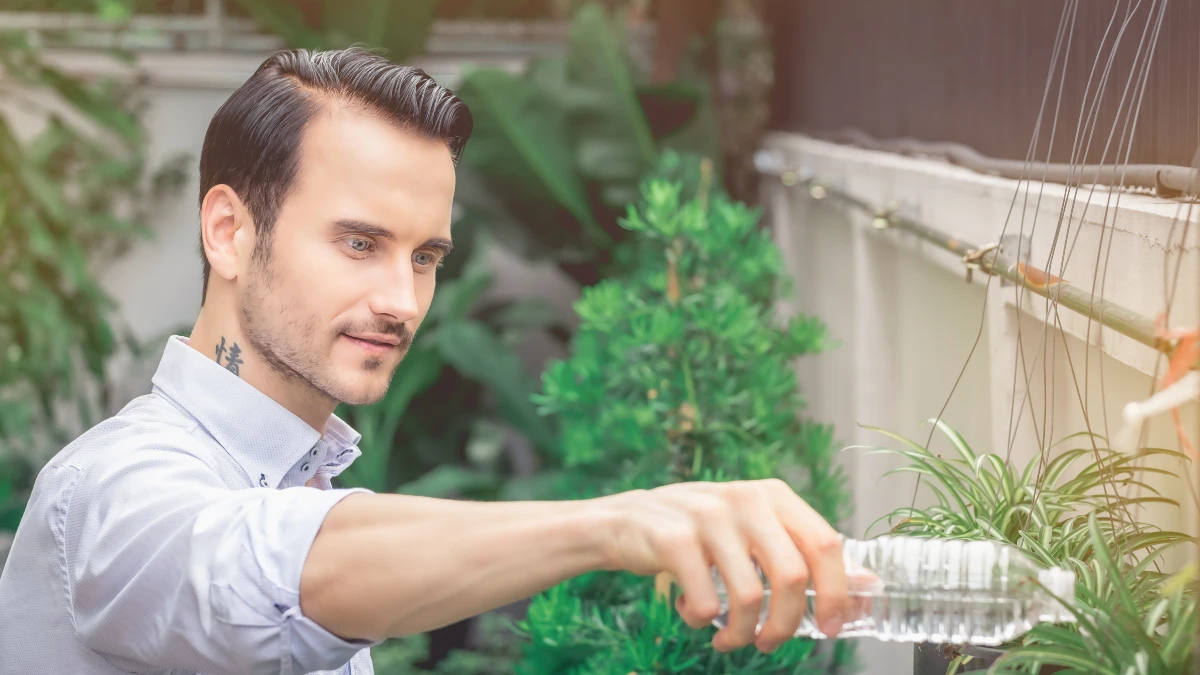
What to check right now
- Classic signs: The plant wilts even while the soil feels wet. Leaves yellow. A sour or swampy smell comes from the pot. Fungus gnats hover over the mix. These are red flags for soggy roots and early rot.
- Roots tell the truth: Slide the plant out gently. Healthy roots are white to tan and firm. Rotting roots are brown/black and mushy and may smell bad. If you see mush, you’re overwatering (and rot organisms love wet soils).
Two fast moisture checks
- Finger test: Push a clean finger 2 inches into the mix. If it feels moist, do not water. If dry, water.
- Lift test: Lift the pot. Light = dry, heavy = still moist.
Fixed calendars fail because plant needs change with light, pot size, mix, and room temperature. Water when the plant needs it, not when the calendar says.
Rule-out checklist
- Drainage holes present? No holes = trapped water and low oxygen.
- Saucer emptied? Water sitting in a saucer keeps roots wet; empty it shortly after watering.
- Potting mix too dense? Heavy, peat-packed or garden soil holds water too long; switch to a well-drained mix.
- Recently repotted into a much larger pot? “Overpotting” leaves excess wet mix around small roots and slows drying. Move up one size only.
Why this matters
University extension sources repeatedly warn that overwatering is the #1 cause of potted plant death because roots need oxygen as well as water. Waterlogged soil cuts off oxygen and sets up root rot, which leads to wilting, yellowing, and collapse.
The Rescue: Step-By-Step Fix for a Soggy Plant
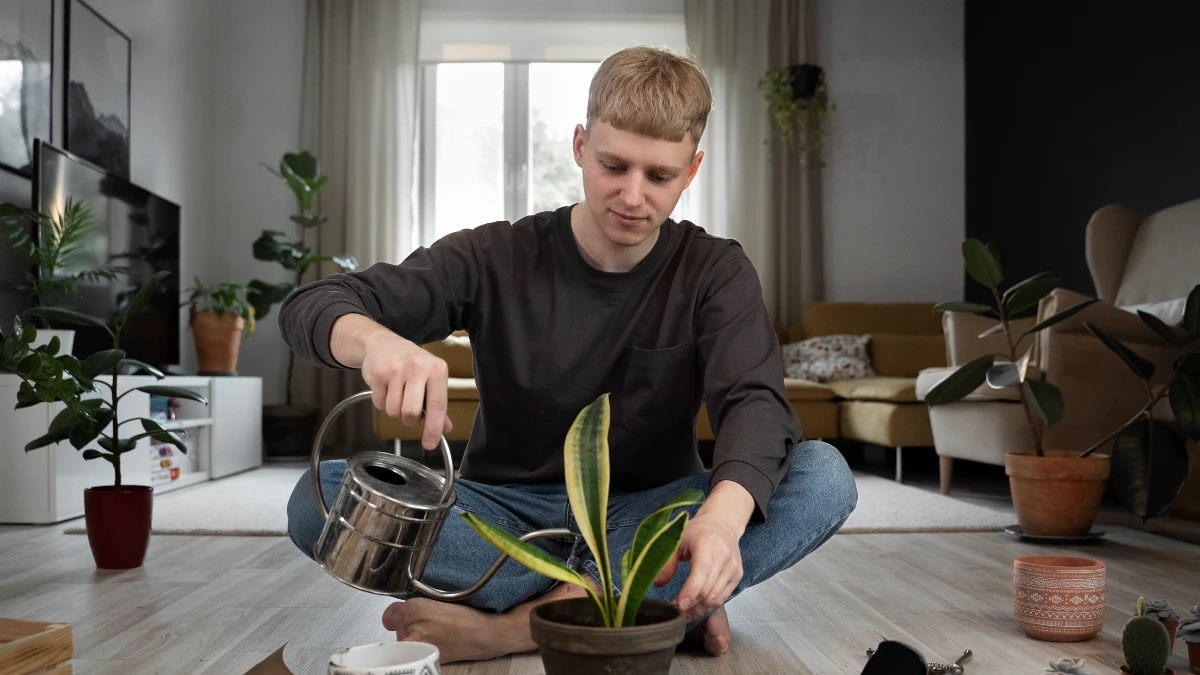
1) Stop watering & drain
Pour out any standing water. If there’s water in the saucer or cachepot, empty it within an hour of watering so roots aren’t sitting in a bath.
2) Unpot & inspect roots
Slide the plant out. Trim off brown, mushy roots with clean scissors. Keep white, firm roots. Wipe blades with alcohol between cuts. Discard the old, sour mix.
3) Choose the right container
Use a pot with drainage holes. If your decorative container has no hole, double-pot: keep the plant in a plain nursery pot and set it inside the pretty one. Don’t add a gravel layer inside the pot; it raises the saturated zone and worsens waterlogging.
4) Reset the mix
Repot into fresh, pasteurized/sterile media that drains well. A simple, proven blend is ~⅓ soil, ⅓ peat/coir, ⅓ perlite or vermiculite. Avoid garden soil in containers. Water once to settle, let it drain fully, then empty the saucer.
5) Aftercare
Place the plant in bright, appropriate light and good airflow. Water thoroughly, then wait until the top 1–2 inches are dry by finger test before watering again. Never leave the pot sitting in runoff.
Why this works
You’re removing rot sources, restoring oxygen around roots, and switching to a structure that holds moisture but drains fast, which helps prevent root rot in pots and is the core of how to stop overwatering your plants.
Install a Watering System That Works (and Lasts)
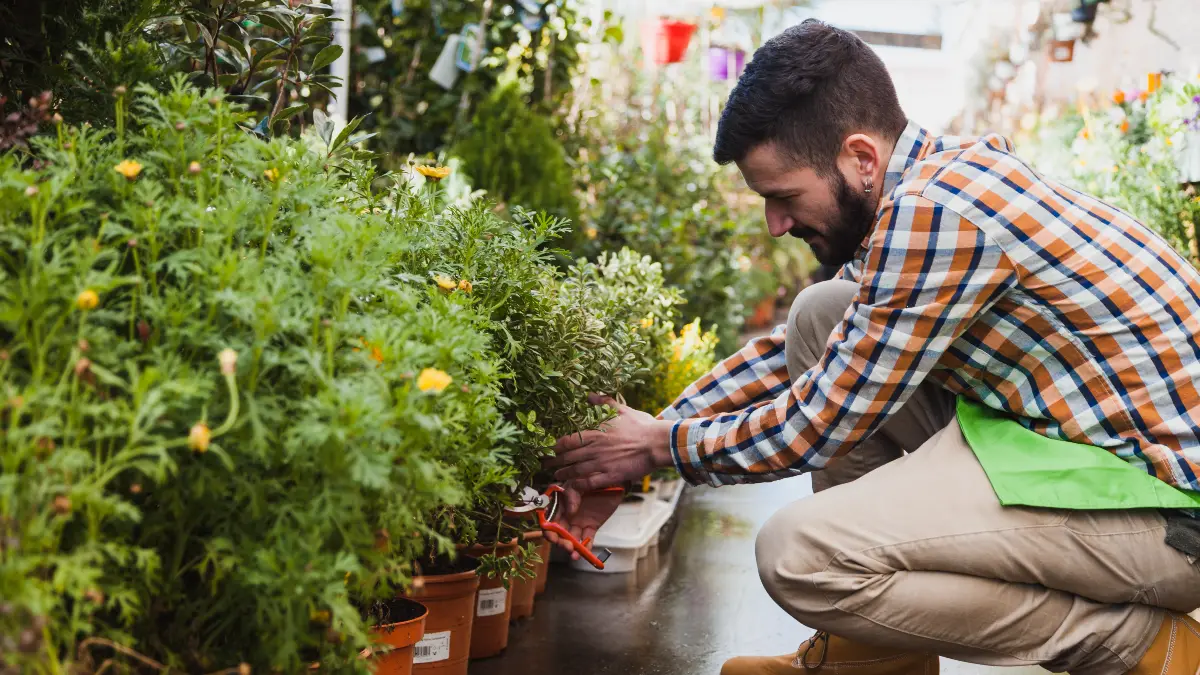
When to water
Use two signals together:
- Finger test (2 inches).
- Lift test (weight).
Skip fixed schedules. Plant needs change with season, light, and room conditions.
How to water
- Top-watering: Add water until it drains out of the holes. This pushes water through the whole root zone and washes extra salts. Always empty the saucer.
- Bottom-watering: Set the pot in a tray/sink of water until the surface turns evenly moist, then remove and drain. Never let plants sit in water.
Seasonal tweaks
Plants use less water in winter because light is low and growth slows. Expect longer dry times between waterings and water much less. The lift test is extra helpful now.
Optional tools (use smarter, not blind)
- Moisture meters can help, but accuracy varies with salts and soil type. Confirm with your finger test until you trust your meter.
- Self-watering planters (SWP): These pots wick water from a bottom reservoir and many have an overflow hole to prevent overfill. They help smooth moisture swings if you still check the top few inches and keep the reservoir clean.
Leaching cadence
Every 3–4 months (Maryland Extension: 4–6 months), flush pots with clear water to leach salts that cause brown tips and can mimic overwatering stress. Let water run through at least 2× pot volume, then drain and empty the saucer.
Container & Mix Choices That Prevent Overwatering

Drainage, then style
Pick containers with holes and always empty saucers. Using a decorative outer pot? Double-pot so you can lift the inner pot to drain runoff.
Terracotta vs. plastic
- Terracotta (clay) dries faster because it breathes.
- Plastic/glazed containers hold moisture longer.
Match container to plant habits and your watering pace.
Skip the gravel layer
Gravel at the bottom doesn’t improve drainage. It raises the water-saturated zone and keeps roots wetter. Use a proper mix instead.
Self-watering planters
Reservoir + wicking column delivers moisture steadily; overflow protects against overfilling. SWPs help busy plant parents, but you still need to check the top 1–2 inches and empty any captured overflow.
Plant-Specific Watering Rules (Succulents vs. “Even-Moisture” Tropicals)
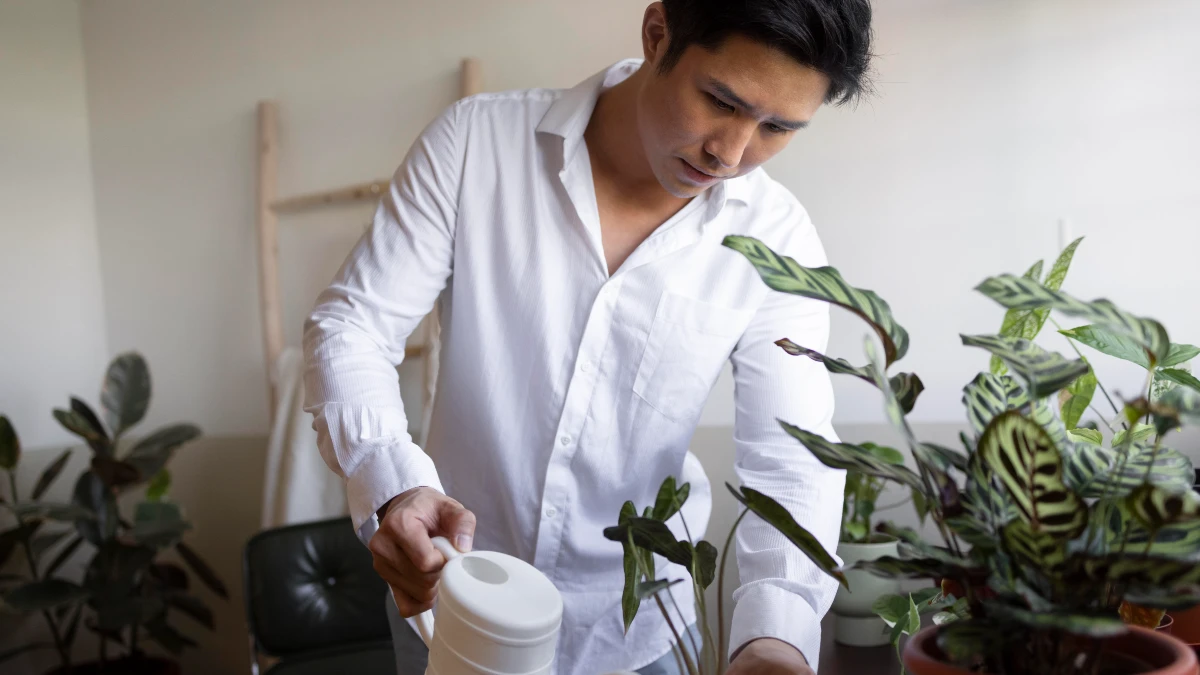
Succulents/cacti
Use a wet–dry cycle. Water thoroughly, then let the mix dry completely before the next irrigation. Overwatering causes soft growth and rot.
Even-moisture tropicals (e.g., peace lily)
Keep the mix evenly moist, not soggy. Water when the top inch feels slightly dry. Peace lily often wilts to signal thirst, but can also wilt if overwatered, so confirm with the finger test.
Environment changes frequency
Light, temperature, humidity, pot size, and mix all change how often you’ll water. Warmer, brighter rooms dry pots faster; large pots with dense mixes stay wet longer. Adjust by testing, not by dates.
Troubleshooting: Fungus Gnats, Moldy Soil, and “Wilting While Wet”
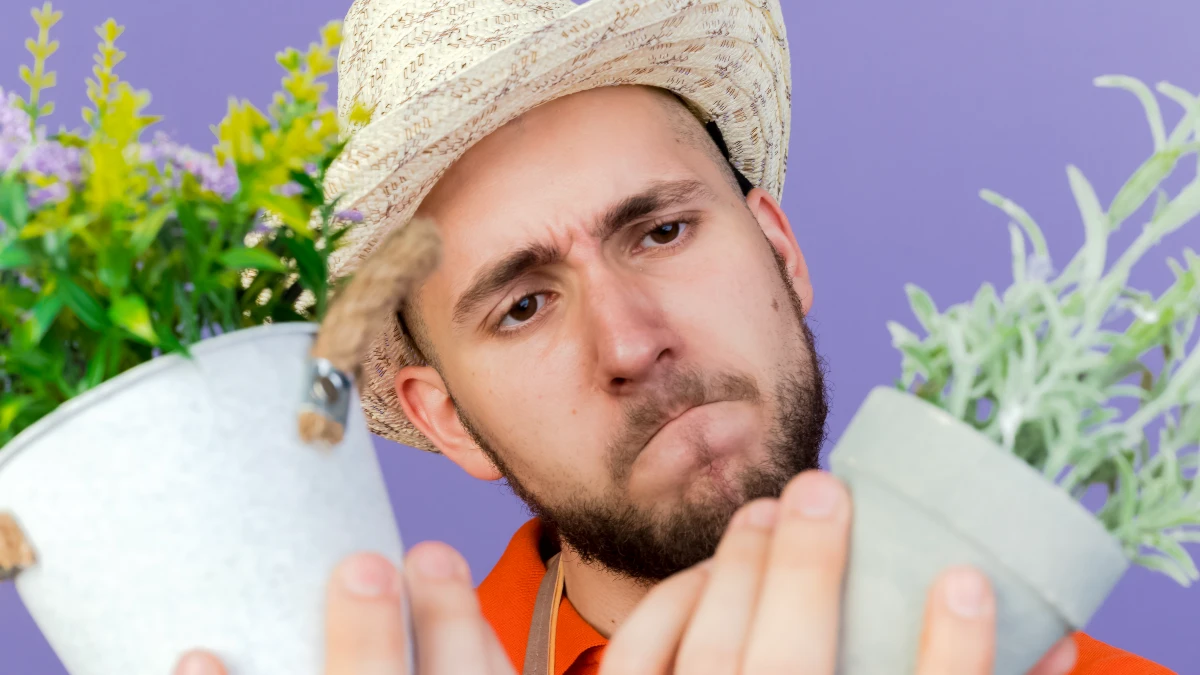
Wilting while wet
That’s a classic root rot pattern. Unpot and check roots right away. Trim mushy roots, repot in fresh mix, and fix your watering. Sometimes, discarding a plant that’s mostly rotten is the best move.
Fungus gnats
They love constantly moist soil. Let the top 1–2 inches dry between waterings to break their life cycle. Use yellow sticky traps to catch adults while you reset your watering.
Mold or green algae on soil
This means the surface stays wet. Space out waterings, scrape off the growth, and improve airflow/light. Check drainage and empty saucers.
When to toss
If most roots are black/mushy and the plant is collapsing, discard and sanitize tools to avoid spreading pathogens.
BONUS: Quick reference to the key sources cited

- Clemson HGIC — overwatering is the main cause of potted plant death; roots need oxygen; how to water and meters caveat.
- UMD Extension — don’t water on a schedule; finger/lift tests; top vs bottom watering; leach every 4–6 months.
- Wisconsin Horticulture — root rot diagnosis (wilt while wet, brown/mushy roots), when to discard.
- UConn — empty saucers within ~1 hour; clay dries faster; double-potting tip.
- Illinois Extension — ⅓-⅓-⅓ potting blend; overpotting warning; drainage and self-watering planter mechanics.
- MSU Extension — water much less in winter; lift test.
- WSU — gravel-layer myth (raises perched water table).
- UMN Extension — fungus gnat control (let surface dry, sticky traps).
- Iowa State Yard & Garden — succulents wet–dry cycle.
Writing Rules (how I’ve written it — and how to keep it consistent)
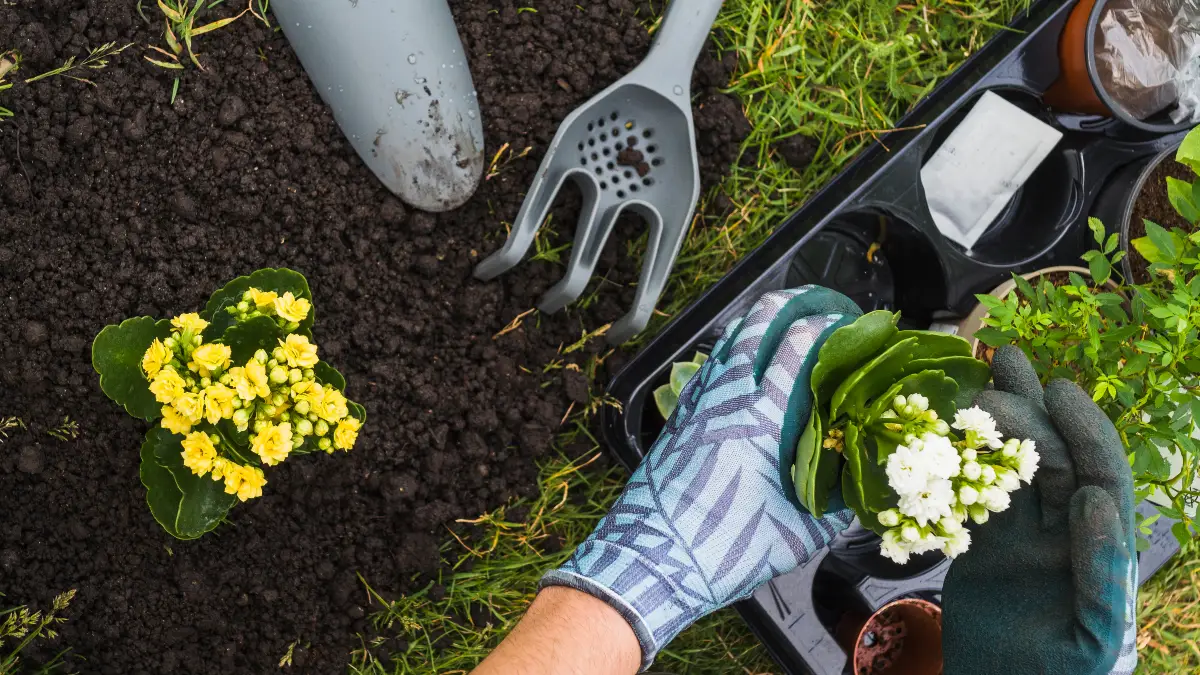
- Tone: friendly, plain, and direct. Professional but not stiff.
- Sentence length: mix short lines with a few longer ones. One idea per sentence.
- Techniques: start each section with a promise or quick win; use checklists; give if/then fixes; bold decisive actions.
- Keep readers engaged: quick tests, visible steps, and simple thresholds (2-inch finger test; empty saucer in an hour). No fluff.
Content Research Checklist (what to pull as you expand the full article)

- Stats to cite: overwatering as top cause; why roots need oxygen; winter watering reduction; leaching frequency; “wilt while wet” as a rot sign.
- Experts to quote: UW Plant Disease Diagnostics Clinic on root rot; UMD HGIC on watering cadence; Illinois Extension on mixes and containers.
- Examples to include: quick root check photo sequence (healthy vs mushy); finger test photo; saucer with standing water; gravel-layer diagram referencing WSU myth.
- Tools/resources: yellow sticky traps for gnats; basic moisture meter (with warning); self-watering planters with overflow; nursery-pot + cachepot double-potting.
Section-by-Section Writing Guide (openers, bridges, endings, and specifics)

Quick Test
- Start: “Touch the soil. Check the weight. Look for gnats.”
- Bridge: Move from signs → root check → rule-out list.
- End: “If you find mushy roots or water-logged mix, go to The Rescue.”
- Specifics: Include a 3-item table: Sign → What it means → What to do now. Cite rot signs and gnat steps.
Rescue
- Start: “First, stop adding water.”
- Bridge: Drain → unpot/trim → choose pot → mix → aftercare.
- End: “Now switch to the finger + lift tests before every watering.”
- Specifics: Show ⅓-⅓-⅓ recipe; bold “Don’t add gravel.”
Install a Watering System
- Start: “Your plant—not your calendar—sets the schedule.”
- Bridge: When to water → how to water → winter tweak → tools → leaching cadence.
- End: “Set a reminder to leach every 4–6 months.”
- Specifics: Add a mini checklist: Before watering: finger 2″, lift, light check. After watering: empty saucer.
Container & Mix
- Start: “Good drainage beats any fancy pot.”
- Bridge: Holes/saucers → terracotta vs plastic → gravel myth → self-watering basics.
- End: “Pick the combo that matches how you water.”
- Specifics: Small callout: “Decorative pot? Double-pot it.”
Plant-Specific
- Start: “Different plants, different rhythms.”
- Bridge: Succulents (dry cycle) → even-moisture tropicals → environment factors.
- End: “Test, then water. Don’t guess.”
Troubleshooting

